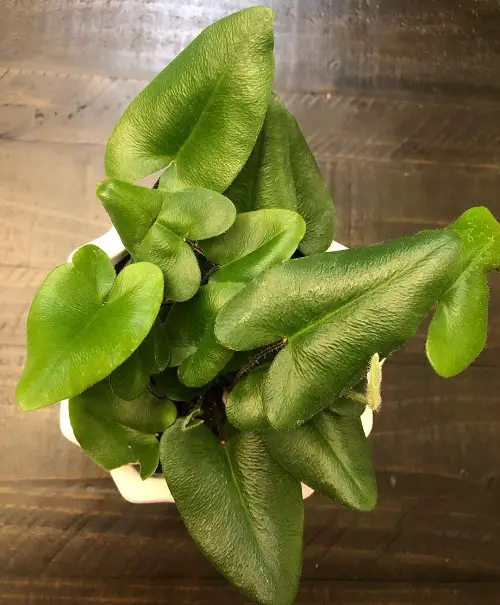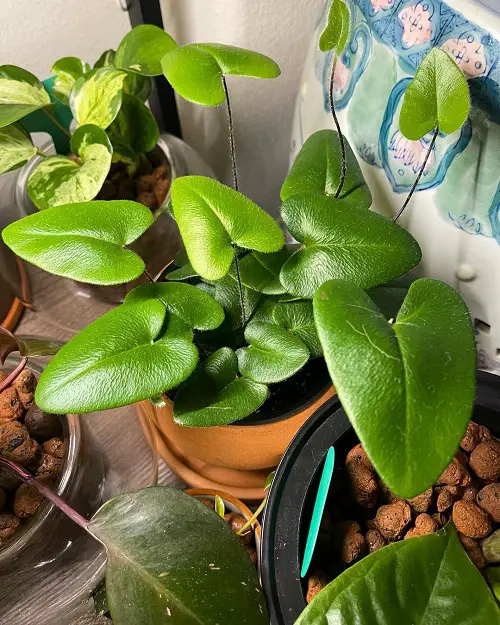Find out How to Grow Heart Fern, a popular houseplant with delicate heart-shaped leaves, by following these easy tips and tricks.

From the perfect soil and light conditions to the right watering and fertilization, we’ll cover everything you need to know to help your heart fern thrive. Read on How to Grow Heart Fern.
Check out our article on growing ferns in the water
Heart Fern Plant Profile
Heart fern, also known as Hemionitis arifolia, is a beautiful houseplant known for its delicate, heart-shaped leaves that belongs to the Pteridaceae. This tropical plant is native to Asia, Africa, and the Americas and is commonly grown as an ornamental plant indoors.
It is a small fern that grows up to 6-8 inches tall. This fern features heart-shaped, dark green-colored fronds with a glossy texture. The fronds are bipinnatifid, which means that they are divided into tiny, finger-like segments.
This fern is native to tropical regions of Central and South America, where it grows in the understory of rainforests. It appreciates warm and humid environments.
Propagating Heart Fern

Heart Fern can be propagated by the spores or division.
Division
- Remove the plant from its pot and gently loosen up the soil around the roots.
- Then, carefully divide the plant into two or more parts by softly tugging and pulling apart the rhizomes.
- Now, plant each section in a new pot with fresh potting soil. Ensure that the soil is moist at all times but not waterlogged.
- Place the plant in a spot with bright, indirect light and humidity above 50 percent.
- You can also use a plastic bag or a cloche as a cover to help maintain humidity.
- Water the new plants regularly. Keep the soil moist but not waterlogged.
- Let them grow until they become established in 3-5 weeks.
Spores
Find a mature plant frond with spores. The spores are located on the underside of the frond and appear as small, brownish spots. Carefully take out the fronds. Place it in a paper bag to let the spores dry and collect. Once the spores are all dried up, you can sprinkle them over the surface of a pot filled with a mix of peat moss and sand in equal parts.
Use a plastic bag to maintain humidity as a cover. Keep the pot in a bright, warm location out of direct sunlight exposure. Check the pot regularly and mist it to keep the soil moist but not waterlogged. In 2-4 weeks, the spores should germinate, and tiny plants should begin to grow. Allow the new plants to grow until they are 5-6 inches tall. Then, transplant them into individual pots.
Growing Requirements of Heart Fern

Light
The Heart fern loves bright, indirect light. Do not place it in direct sunlight, as this can cause its delicate fronds to burn. If the plant is grown in too much shade, it may become leggy and lose its compact shape.
Soil
It appreciates a well-draining soil mix that is rich in organic matter. A mix of peat moss and perlite or vermiculite is perfect. You should keep the soil consistently moist but not waterlogged.
Water
This plant needs regular watering to keep its soil moist but not waterlogged. You should water the plant when the top 2-3 inches of the soil is dry to the touch.
Avoid letting the soil dry out completely, as this can cause the plant to wilt. The plant may need more frequent watering in hot, drier conditions.
Temperature
The Heart fern prefers temperatures between 60-75°F or 15-24°C. It can tolerate slightly cooler temperatures, but you should protect the plant from frost and cold drafts.
Humidity Level
It prefers high humidity levels of 50 percent or more. If the air in your home is dry, you can consider placing the plant on a tray of pebbles filled with water to increase humidity levels around the plant.
Alternatively, you can use a humidifier to increase the humidity in the room. Additionally, you can place the plant in your kitchen or bathroom, as these places are more humid.
Here are the most amazing ferns you can grow in containers
Heart Fern Care

Fertilization
Any regular fertilization routine with a balanced, water-soluble fertilizer can help your heart fern. Fertilize it once a month during the growing season and then cut back fertilization in the fall and winter.
Be sure to dilute the feed to half the strength to avoid burning the delicate roots of the plant.
Pruning
This fern does not need regular pruning, but you can remove any dead or damaged parts to keep the plant looking tidy. Make sure to use clean, sharp scissors or pruning shears to avoid damaging the plant.
Pests and Diseases
The Heart fern is usually pest and disease-resistant, but it can be prone to spider mites and mealybugs. Watch out for any signs of infestation, such as webbing or tiny white bugs, and treat the plant with insecticidal soap or neem oil if necessary.
Overwatering can lead to root rot, so let the soil dry out slightly between waterings to rule out this issue.


